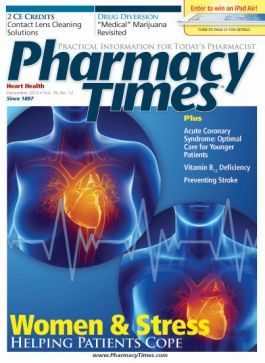Publication
Article
Pharmacy Times
Takeda's Nesina
Author(s):
The FDA has approved Nesina (alogliptin) tablets, along with diet and exercise, for improving control of blood sugar levels in patients with type 2 diabetes mellitus.
In January 2013, the FDA announced approval of Nesina (alogliptin) tablets, along with diet and exercise, for improving control of blood sugar levels in patients with type 2 diabetes mellitus (T2DM).1 Alogliptin, the active ingredient in Nesina, is also approved as a part of 2 combination tablets: Kazano (alogliptin and metformin) and Oseni (alogliptin and pioglitazone). Use of Nesina is contraindicated in patients who have experienced a serious hypersensitivity reaction to alogliptin-containing products. Nesina is not indicated to treat patients with type 1 diabetes mellitus or with diabetic ketoacidosis.2
Pharmacology and Pharmacokinetics
Nesina increases concentrations of incretin hormones such as glucagon-like peptide-1 (GLP-1) and glucose-dependent insulinotropic polypeptide (GIP). These hormones, which originate in the small intestine, help regulate insulin release from the pancreas until dipeptidtyl-peptidase-4 (DPP-4) enzymes degrade GLP-1 and GIP. Nesina works in a glucose-dependent manner, inhibiting DPP-4 enzymes, slowing incretin hormone degradation and improving insulin-dependent responses to high blood glucose levels.2
After single-dose oral administration of Nesina, plasma concentrations peak within about 2 hours. In healthy volunteers, elimination half-life is about 21 hours.2
Relative to Nesina exposure in patients with normal renal function, patients with moderate renal impairment experience an approximately 2-fold increase in exposure, and patients with severe renal impairment and end-stage renal disease (ESRD) experience a 3- to 4-fold increase in exposure.2
Dosage and Administration
Nesina is available in 25-mg, 12.5-mg, and 6.25-mg tablets. The usual starting dose of Nesina is 25 mg orally daily without regard to food. The manufacturer recommends a 50% reduction in the maximum recommended dose to 12.5 mg once daily in patients with moderate renal impairment. A further reduction in the maximum dose to 6.25 mg once daily is recommended in patients with severe renal impairment or ESRD.2
No adjustment in dosage is necessary in patients with mild to moderate hepatic impairment. Nesina has not been studied in patients with severe hepatic impairment.2
Clinical Trials
In 10 studies, investigators tested Nesina in combination with several antidiabetic medications, including metformin, sulfonylureas, thiazolidinediones, and insulin in a total of 8673 patients with T2DM. The mean patient age was 55 years, with patients ranging from 21 to 80 years of age. Each of 3 pivotal trials began with a 4-week period in which all patients took placebo and followed a regimen of diet and exercise. Only patients who were unable to achieve glycemic control with diet and exercise received Nesina.2
Patients receiving monotherapy with Nesina 25 mg experienced an additional 0.6—percentage point reduction in glycated hemoglobin (A1C) over patients receiving placebo (P <.01). By week 26, in an intent-to-treat analysis, nearly half of patients (44%) receiving Nesina 25 mg achieved a goal A1C ≤7% versus just under one-fourth (23%) of patients receiving placebo, a significant difference (P <.01).2
Patients receiving Nesina 25 mg with pioglitazone 30 mg experienced an additional 0.8—percentage point reduction in A1C over patients receiving Nesina 25 mg alone (P <.01). By week 26, almost two-thirds of patients (63%) receiving Nesina 25 mg with pioglitazone 30 mg achieved a goal A1C ≤7%.2
Maximal doses of metformin (2000 mg daily) resulted in a 1.1— percentage point reduction in A1C. Addition of Nesina 25 mg further reduced A1C by an additional 0.4 percentage points by week 26.2
Warnings and Precautions
Use of Nesina with other blood-glucose—lowering medications may lead to hypoglycemia. Adverse reactions observed in clinical trials include nasopharyngitis, headache, and upper respiratory tract infection, each occurring in ≥4% of patients, and more frequently than in patients receiving placebo.2
In patients with T2DM, elevations of serum alanine aminotransferase higher than 3 times the upper limit of normal have occurred in 1.3% of patients treated with Nesina compared with 1.5% of patients treated with background therapy. Fatty liver disease resulting from T2DM may be the underlying cause of elevated liver enzymes in some of these cases. Regardless of causality, in patients with T2DM, it is advisable to conduct a liver test panel in patients initiating Nesina.2
Acute pancreatitis has been reported in postmarketing studies of patients receiving Nesina. Patients experiencing this adverse event should discontinue Nesina and use alternate treatment.2
No clinically significant drug interactions have been observed with Nesina, although Nesina is minimally metabolized by CYP2D6 and CYP3A4. For a complete discussion of potential drug interactions and adverse events, please consult the package insert.2
Michael R. Page earned his PharmD from the Ernest Mario School of Pharmacy at Rutgers University. He has worked as a community pharmacist at CVS Pharmacy and is currently clinical editor in clinical and scientific affairs at Pharmacy Times.
References
- Food and Drug Administration. FDA approves three new drug treatments for type 2 diabetes. www.fda.gov/NewsEvents/Newsroom/PressAnnouncements/ucm336942.htm. Accessed October 2013.
- NESINA (alogliptin) tablets [package insert]. Deerfield, IL: Takeda Pharmaceuticals America, Inc; 2013.

Newsletter
Stay informed on drug updates, treatment guidelines, and pharmacy practice trends—subscribe to Pharmacy Times for weekly clinical insights.






